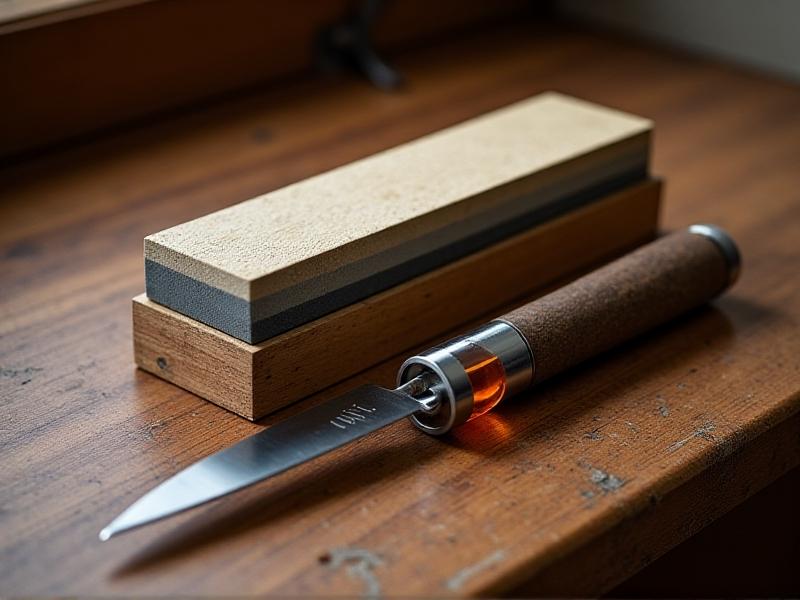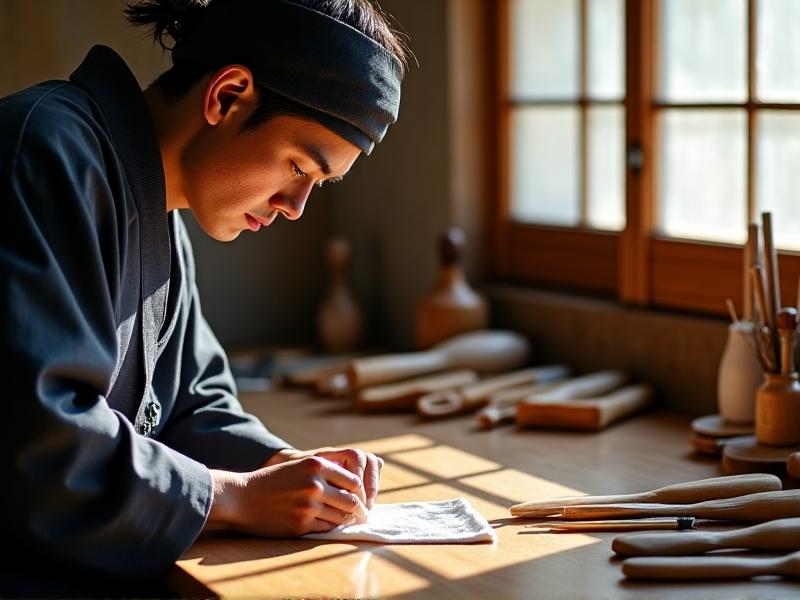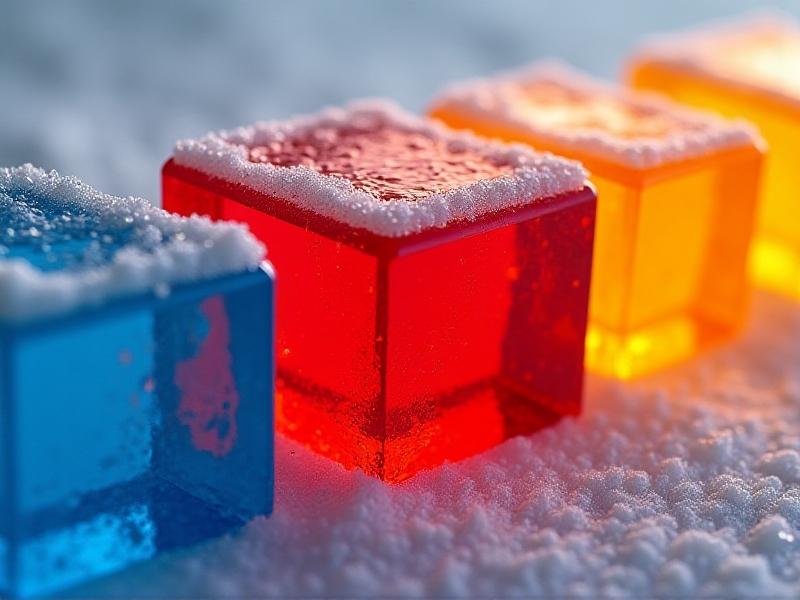Step-by-Step Guide to Honing Japanese Ice Carving Chisels
Understanding the Basics of Japanese Ice Carving Chisels
Japanese ice carving chisels are specialized tools designed for precision and durability. Unlike standard woodworking chisels, these tools are crafted to withstand the unique challenges of carving ice, such as extreme cold and the material's brittleness. The chisels typically feature high-carbon steel blades that retain sharpness even under harsh conditions, and ergonomic handles that provide a comfortable grip during prolonged use.
To begin honing these chisels, it's essential to understand their anatomy. The blade, or "kireha," is the primary cutting edge, while the handle, or "tsuka," is often made from wood or synthetic materials to ensure a firm grip. The tang, or "nakago," connects the blade to the handle, ensuring stability and balance. Familiarizing yourself with these components will help you identify areas that require attention during the honing process.
Additionally, it's crucial to recognize the different types of chisels used in ice carving. Flat chisels, gouges, and V-tools each serve specific purposes, from shaping large blocks to adding intricate details. Knowing which chisel to use for a particular task will not only improve your carving efficiency but also ensure that your tools remain in optimal condition.

Gathering the Necessary Tools and Materials
Before you start honing your Japanese ice carving chisels, it's important to gather all the necessary tools and materials. This preparation will ensure a smooth and efficient process. Essential items include a sharpening stone, honing guide, lubricant, and a clean cloth. A sharpening stone, or "toishi," is the cornerstone of the honing process. It comes in various grits, from coarse to fine, allowing you to gradually refine the blade's edge.
A honing guide is a valuable tool for maintaining the correct angle while sharpening. It ensures consistency and precision, which are crucial for achieving a sharp edge. Lubricants, such as water or oil, are used to reduce friction and prevent the blade from overheating. This not only protects the blade but also enhances the sharpening process by allowing the stone to work more effectively.
Lastly, a clean cloth is essential for wiping down the blade and removing any debris or residue. Keeping your tools clean during the honing process will prevent contamination and ensure a smooth finish. By gathering these tools and materials, you'll be well-prepared to begin honing your Japanese ice carving chisels.

Preparing the Chisel for Honing
Proper preparation is key to achieving a sharp and durable edge on your Japanese ice carving chisels. Start by cleaning the blade thoroughly to remove any ice residue, dirt, or rust. Use a soft cloth and a mild cleaning solution to ensure the blade is free from contaminants. This step is crucial because any debris on the blade can interfere with the honing process and result in an uneven edge.
Next, inspect the blade for any nicks, chips, or irregularities. These imperfections can affect the chisel's performance and should be addressed before honing. If you notice any significant damage, you may need to use a coarse sharpening stone to reshape the blade. For minor imperfections, a medium-grit stone should suffice. The goal is to create a smooth and even surface that can be further refined during the honing process.
Once the blade is clean and free from imperfections, secure it in the honing guide. Adjust the guide to maintain the correct angle, typically between 25 and 30 degrees, depending on the chisel's design. This angle ensures a sharp edge while maintaining the blade's durability. With the chisel properly prepared, you're ready to begin the honing process.

Honing the Blade: Step-by-Step Process
Honing a Japanese ice carving chisel involves a series of precise steps to achieve a sharp and durable edge. Begin with a coarse sharpening stone to remove any significant imperfections and reshape the blade if necessary. Apply a few drops of lubricant to the stone and hold the chisel at the correct angle, as determined by the honing guide. Move the blade back and forth across the stone in smooth, consistent strokes, applying even pressure.
After using the coarse stone, switch to a medium-grit stone to refine the edge further. This step removes the scratches left by the coarse stone and begins to create a sharper edge. Continue using the same technique, ensuring that you maintain the correct angle and apply consistent pressure. As you progress, you'll notice the blade becoming smoother and more refined.
Finally, use a fine-grit stone to polish the blade and achieve a razor-sharp edge. This step is crucial for enhancing the chisel's performance and ensuring a clean cut. After honing, wipe the blade with a clean cloth to remove any residue and inspect the edge for sharpness. If necessary, repeat the process until you achieve the desired result. With practice, you'll develop the skill and precision needed to hone your Japanese ice carving chisels effectively.
Maintaining the Edge: Post-Honing Care
Once you've honed your Japanese ice carving chisels, it's important to maintain the edge to ensure longevity and performance. Start by storing the chisels in a dry, cool place to prevent rust and corrosion. Consider using a protective sheath or case to keep the blades safe from damage and contamination. Proper storage not only extends the life of your tools but also ensures they're ready for use whenever needed.
Regular maintenance is also essential for keeping the edge sharp. After each use, clean the blade thoroughly to remove any ice residue or debris. Inspect the edge for any signs of wear or damage, and address any issues promptly. Periodic honing, even if the chisel appears to be in good condition, can help maintain the edge and prevent the need for more extensive sharpening in the future.
Additionally, consider using a strop or leather honing pad to keep the edge polished and sharp. This tool is particularly useful for maintaining the fine edge achieved during the honing process. By incorporating these maintenance practices into your routine, you'll ensure that your Japanese ice carving chisels remain in optimal condition for years to come.
Advanced Techniques for Precision Honing
For those looking to take their honing skills to the next level, advanced techniques can provide even greater precision and control. One such technique is the use of a micro-bevel, which involves creating a secondary angle on the blade's edge. This micro-bevel enhances the edge's durability and sharpness, making it ideal for intricate ice carving work. To create a micro-bevel, adjust the honing guide to a slightly steeper angle and follow the same honing process as before.
Another advanced technique is the use of a honing compound, which can be applied to a leather strop or honing pad. This compound contains fine abrasive particles that polish the blade and refine the edge. After honing with a fine-grit stone, apply the compound to the strop and move the blade across it in smooth, even strokes. This step adds an extra layer of sharpness and ensures a clean, precise cut.
Finally, consider experimenting with different honing angles to find the optimal edge for your specific needs. While the standard angle is typically between 25 and 30 degrees, some carvers prefer a slightly steeper or shallower angle depending on the type of ice and the level of detail required. By exploring these advanced techniques, you can fine-tune your honing process and achieve exceptional results in your ice carving projects.
Troubleshooting Common Honing Issues
Even with careful preparation and technique, you may encounter some common issues while honing your Japanese ice carving chisels. One frequent problem is an uneven edge, which can result from inconsistent pressure or an incorrect angle. To address this, double-check the honing guide's settings and ensure that you're applying even pressure throughout the process. If necessary, start over with a coarse stone to reshape the blade and create a uniform edge.
Another issue is a burr, or a thin strip of metal that forms on the blade's edge during honing. While a small burr is normal, it can affect the chisel's performance if not removed. To eliminate the burr, use a fine-grit stone or a leather strop to polish the edge. Move the blade in the opposite direction of the honing strokes to ensure the burr is completely removed.
Lastly, if you notice that the blade is not holding its edge after honing, it may be due to over-honing or using the wrong grit. Over-honing can weaken the blade, while using a grit that's too fine too soon can result in an ineffective edge. To fix this, start with a coarser stone and gradually work your way up to a finer grit. By troubleshooting these common issues, you'll be able to achieve a sharp and durable edge on your Japanese ice carving chisels.
Incorporating Honing into Your Ice Carving Routine
Honing your Japanese ice carving chisels should be an integral part of your ice carving routine. Regular honing not only maintains the edge but also enhances your overall carving experience. Start by setting aside time before each carving session to inspect and hone your chisels. This practice ensures that your tools are in optimal condition and ready for use.
Additionally, consider honing your chisels immediately after each session to remove any ice residue and prevent rust. This post-carving maintenance is particularly important in cold environments where moisture can accumulate on the blades. By incorporating honing into your routine, you'll develop a habit of caring for your tools, which will pay off in the long run.
Finally, keep a honing journal to track your progress and note any observations or adjustments. This journal can help you identify patterns, such as which chisels require more frequent honing or which techniques yield the best results. Over time, this record will become a valuable resource for refining your honing skills and improving your ice carving projects.
Exploring the Art of Japanese Ice Carving
Japanese ice carving is a unique and intricate art form that requires both skill and precision. The tools you use, particularly the chisels, play a crucial role in the quality of your work. By mastering the art of honing these chisels, you'll be able to create stunning ice sculptures that reflect the beauty and tradition of this craft.
One of the key aspects of Japanese ice carving is the attention to detail. From large-scale sculptures to delicate ornaments, each piece requires a steady hand and a sharp tool. Honing your chisels to perfection ensures that you can achieve the level of detail needed for these intricate designs. Whether you're carving a traditional Japanese lantern or a modern abstract piece, a well-honed chisel will make all the difference.
Additionally, Japanese ice carving often incorporates natural elements, such as flowers, animals, and landscapes. These designs require a deep understanding of the material and the ability to work with its unique properties. By honing your chisels and practicing your technique, you'll be able to bring these natural elements to life in your ice sculptures. The art of Japanese ice carving is a journey of continuous learning and improvement, and honing your chisels is an essential part of that journey.
Conclusion: The Path to Mastery
Honing Japanese ice carving chisels is a skill that requires patience, practice, and attention to detail. By understanding the basics, gathering the necessary tools, and following a step-by-step process, you can achieve a sharp and durable edge that enhances your carving experience. Regular maintenance and advanced techniques will further refine your skills and ensure that your tools remain in optimal condition.
As you continue to hone your chisels and explore the art of Japanese ice carving, you'll develop a deeper appreciation for the craftsmanship and tradition behind this unique art form. Each honing session is an opportunity to improve your technique and bring your creative visions to life. With dedication and practice, you'll master the art of honing Japanese ice carving chisels and create stunning ice sculptures that reflect your skill and passion.







